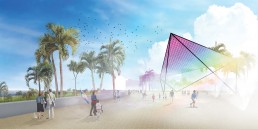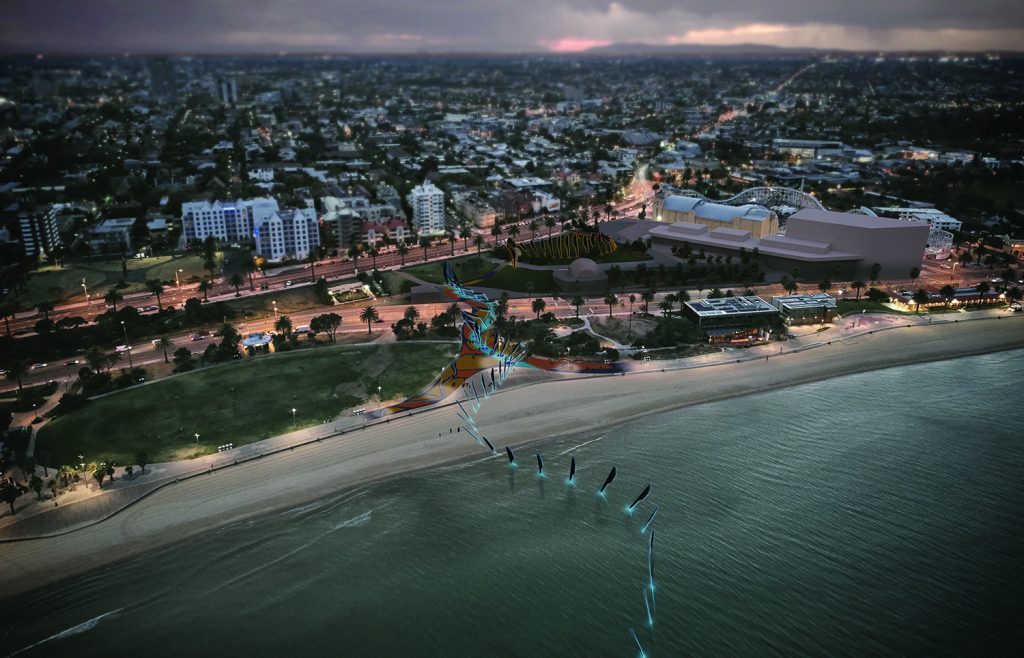
Artist Team: Soren Luckins, Ashleigh Adams, George Thompson, Kate Luckins, Alan Pears, Erin Pears, Peter Bennetts, Jasmine Sarin, Elder Arweet Carolyn Briggs, Rae Fairbairn, Dave Stelma
Energy Technologies: amorphous silicon thin-film photovoltaic
Annual Capacity: 400 MWh
A submission to the Land Art Generator Initiative 2018 Competition for Melbourne
A design team from Australia sought guidance from St Kilda’s original custodians before entering the 2018 Land Art Generator design competition for Melbourne.
Faced with creating a work of public art that also generates clean energy for the City of Port Phillip, the Büro North team first consulted with the Boon Wurrung Foundation to ensure their design would resonate with all people who spend time at the historic site along Port Phillip Bay.
Boon Wurrung Elder N’arweet Carolyn Briggs told LAGI over email that Euro Yuroke (as St Kilda was originally known) and the surrounding land existed before the end of the last ice age, and that the Yaluk-ut Weelam people were the last of the survivors.
“Büro North designers have taken it to another level by bringing in a new way of seeing this Country, which will benefit not only us as custodians, but also increase the knowledge and well-being of all people that now reside on this land,”says Elder Briggs.
Led by Soren Luckins, the 12-member strong Ngargee team incorporated what they learned about St Kilda’s history into their solar-powered design.
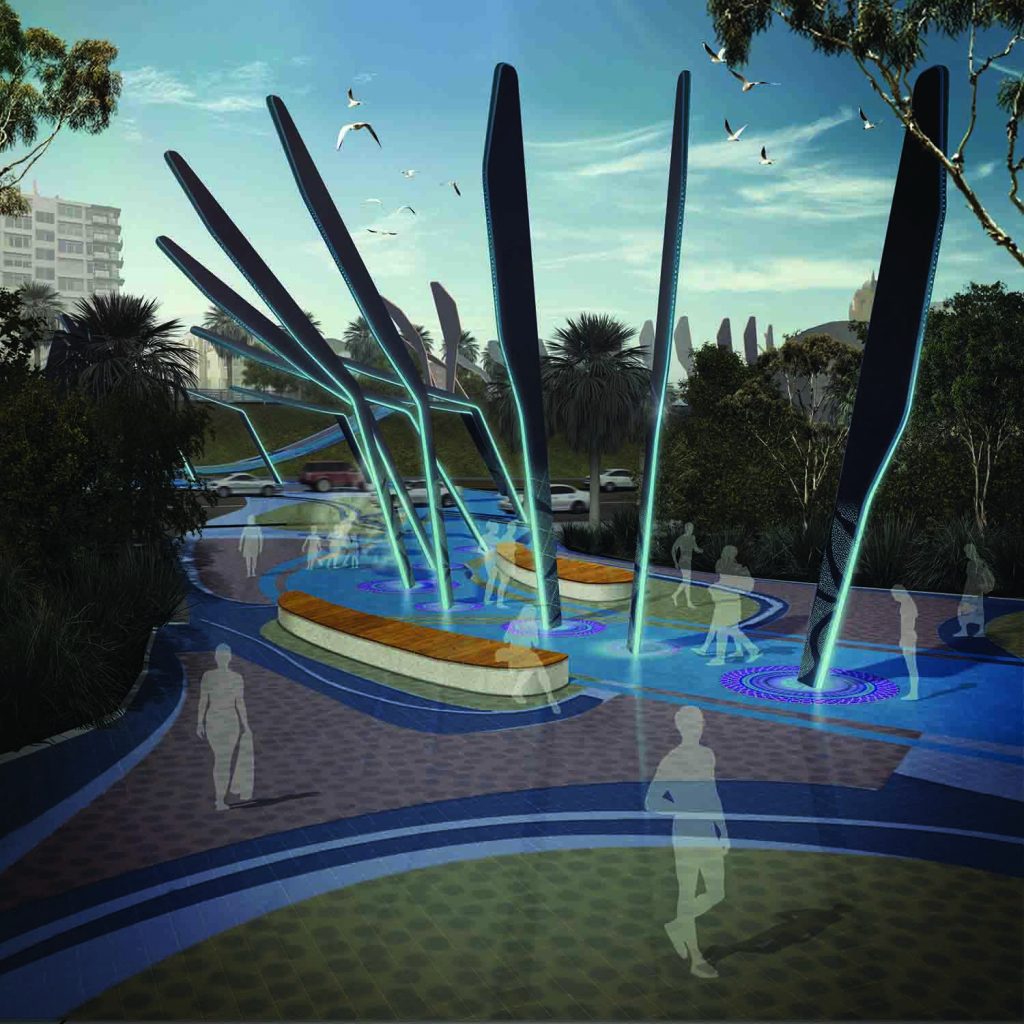
Artist Team: Soren Luckins, Ashleigh Adams, George Thompson, Kate Luckins, Alan Pears, Erin Pears, Peter Bennetts, Jasmine Sarin, Elder Arweet Carolyn Briggs, Rae Fairbairn, Dave Stelma
Energy Technologies: amorphous silicon thin-film photovoltaic
Annual Capacity: 400 MWh
A submission to the Land Art Generator Initiative 2018 Competition for Melbourne
“In creation stories from our first people Bunjil (a creator deity embodied in the form of an eagle) was angered by the neglect of the land, the wasting of fish and yams and the breaking of the laws of nature,” they write in their artistic narrative. “As a consequence; the seas were rising and flooding the land.”
The Boon Wurrung people promised to change their ways and respect the land, so Bunjil walked out to sea, raised his spear, and directed the sea to stop from rising. This is how Port Philip Bay was created, according to legend. Today, we are facing a new era of environmental catastrophe, which also requires a new response.
“In our current climate the narrative of Bunjil protecting the land remains pertinent, as we must repair the broken relationship between humans, the land and the sea.”
Luckins says this idea was the driving principle behind their creation. In addition to creating a sculptural installation that generates renewable energy, they also sought to create additional cultural benefits that demonstrates how Ngargee contributes to a sustainable future, socially, environmentally, and economically.
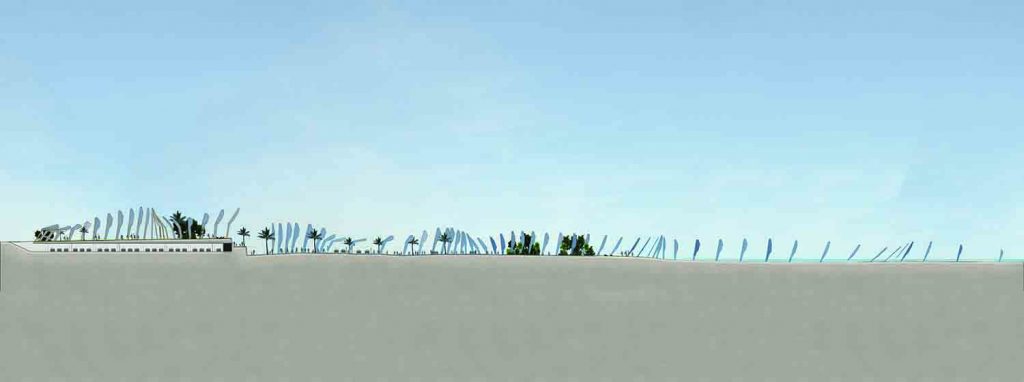
Artist Team: Soren Luckins, Ashleigh Adams, George Thompson, Kate Luckins, Alan Pears, Erin Pears, Peter Bennetts, Jasmine Sarin, Elder Arweet Carolyn Briggs, Rae Fairbairn, Dave Stelma
Energy Technologies: amorphous silicon thin-film photovoltaic
Annual Capacity: 400 MWh
A submission to the Land Art Generator Initiative 2018 Competition for Melbourne
The installation consists of 87 feather-like forms (representing Bunjil’s feathered wings) aligned to create the appearance of an enclosure without closing in the landscape or disrupting views to the bay. Up to 70% of each feather made with recycled steel and aluminum would be coated with a thin, Unisolar film.
Additional photovoltaic cells embedded in the installation’s 235-meter pathway will produce further clean energy, which can be used to power LED lighting, events, and electric bicycle charging.
Any leftover energy would be fed into the City grid. Luckins says they envision using the revenue generated from surplus energy to fund site programs, including live music, community events, and interpretive platforms to educate visitors.
Elder Carolyn Briggs says this will be a great teaching tool for the younger generations and contribute to the health and well-being of people in the City of Port Phillip—something the site has always represented.
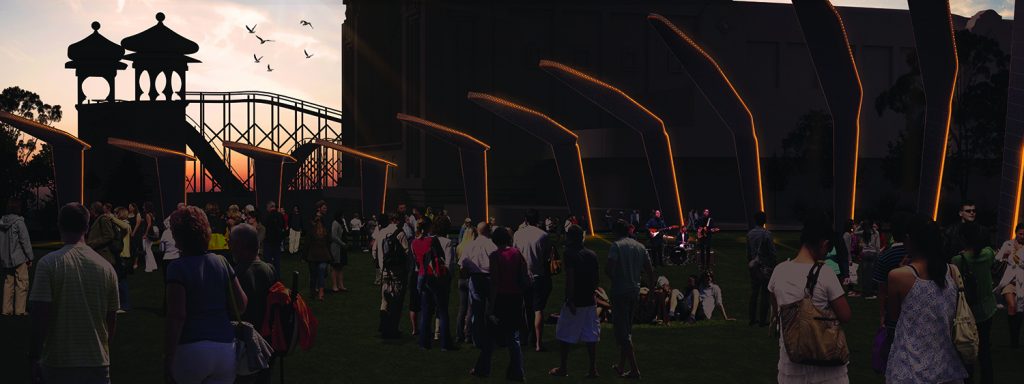
Elder Briggs is thrilled with the design, which she says is unique and tangible.
“Büro North took the time to find the Traditional Owners to create a new narrative with them using new technology,” she adds. “This is the first time in history a new narrative has been created from old knowledge.”
LAGI co-founders Elizabeth Monoian and Robert Ferry, who urge participants to respect the local cultures of various competition sites without appropriation, are encouraged that the Boon Wurrung support the balance in the design achieved by Büro North.
“It is important to us that LAGI designs are culturally relevant, which requires building a deep understanding of the people and the place. This can come through diligent research from a distance, or through designers living with and interacting with those who call the area home. We were delighted to see that Büro North built a relationship with members of the Boon Wurrung and how this informed their concept from the start.”
Tafline Laylin is a freelance communicator and journalist who strives for global environmental and social justice. Her work has appeared in The Guardian, The Atlantic, OZY.com, and a variety of other international publications.

